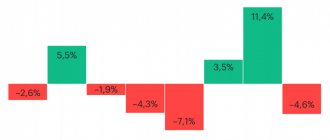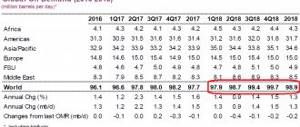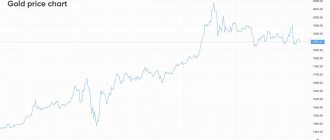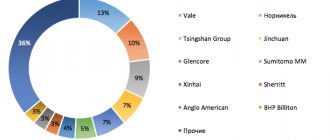The oil market in 2018 is our topic today! What will this market be like, what factors will influence it, and what will happen next with the shale revolution in the United States and the OPEC+ agreement?
The information and analytical news service of the Forex broker InstaForex on its website. We present to your attention the most important and interesting points.
Main exporting countries of liquid petroleum products
To understand the behavior of oil, it is important to know the sources of its production and the supply routes from producers to major consumers.
The media regularly leak information about the leading oil powers - Saudi Arabia, Russia, and the USA.
More accurate information can be obtained from the list of leading oil production countries
Table 1. List of top 10 countries by oil production in 2018
| State | Oil production volume, million bar/day |
| Saudi Arabia | 11,3 |
| Russia | 11,3 |
| USA | 10,4 |
| Iraq | 4,6 |
| China | 4,0 |
| Iran | 3,7 |
| UAE | 3,1 |
| Kuwait | 3,0 |
| Brazil | 2,5 |
| Venezuela | 2,4 |
As you can see, Russia and Saudi Arabia, and along with them the United States, share the top three among countries pumping the maximum amount of oil per day.
In addition to oil production, to understand the situation on the hydrocarbon market, you also need to know which countries have the largest oil reserves, and this list differs from the previous one.
Table 2. List of countries by proven oil reserves in 2018
| A country | Volume of proven oil reserves, billion bar |
| Venezuela | 47 |
| Saudi Arabia | 37 |
| Canada | 28 |
| Iraq | 22 |
| Iran | 20 |
| Kuwait | 14 |
| UAE | 13 |
| Russia | 13 |
| Libya | 6 |
| USA | 5 |
After analyzing the second table, it becomes clear that the world leader in both production and reserves is the Middle East and, above all, Saudi Arabia and the countries of the Persian Basin. Here, the most expensive grades of oil are located in the uppermost layers of the soil, easily extracted and therefore extremely convenient for production.
Russia, despite its leadership in oil production, will begin to cede its leadership in the future and reduce the production of liquid hydrocarbons. The same applies to an even greater extent to the United States - shale oil reserves are also insignificant and will decrease every year. You can see data on how the number of drilling stations in the United States has changed over the past 10 years on the graph.
More importantly, China's production is falling every year and by 2020 could be down 20% from 2017 levels. This is due to the depletion of explored deposits and the growing demand of Chinese industry. On the other hand, China's oil demand will increase to 14 million barrels per day by 2021.
Infographic 1. Number of drilling rigs in the USA from Baker Hughes over the past 10 years
But in Venezuela and Canada, huge oil reserves have been explored, but the trouble is that they belong to bitumen sands and heavy grades, and for production here you will have to spend more money, and This means that the cost of such oil will rise.
China's looming collapse
The second most important factor influencing global processes is the Chinese economy. Now everyone is discussing the trade confrontation between China and the United States, but another topic may soon come to the fore. The growth rate of the Chinese economy fell to its lowest level since 1990 (+6.5%). Prices in China are growing rapidly, and the rise in real estate prices is causing concern (per square meter of housing in Beijing is already asking for more than 11 thousand dollars, and this is not necessarily in the center). Borrowing by Chinese companies is growing at a rapid pace; in this regard, the Chinese are even more active than American businessmen. Shares of the Shanghai Stock Exchange are falling for the third year in a row, quotes remain 2.3 times lower than the 2007 record. The situation is very reminiscent of a huge soap bubble that is about to burst.
List of oil consuming countries in 2018
However, the price is influenced not only by producers, but also by consumers of hydrocarbons. If a country lacks energy and chemical raw materials produced on its own, it will strive to buy them on the foreign market.
It is consumers who dictate the daily demand for oil. As it turned out, the consumption of petroleum products grows every year and naturally accelerates the price of black gold. It is assumed that the increase in oil consumption is associated with the constant growth of the Earth's population and this trend has not yet been reversed, despite a slight slowdown in the growth of the number of earthlings in recent years.
The list of major oil buyers is very different from the list of oil exporting countries.
Table 3. List of main oil consuming countries in 2018
| A country | Volume of oil consumption, million bar/day |
| USA | 19,4 |
| China | 11,0 |
| India | 4,2 |
| Japan | 4,2 |
| Saudi Arabia | 3,9 |
| Brazil | 3,2 |
| Russia | 3,1 |
| South Korea | 2,6 |
| Germany | 2,3 |
| Canada | 2,3 |
If we compare the data in Table 3 with the data given in the first table, the fact is clearly revealed that despite the leadership in consumption, the United States does not have enough of its own oil and is most dependent on the export of petroleum products. The same can be said about other Asian countries, primarily Japan, Korea and China consume very significant volumes of oil, and will continue to consume even more in the future, as their own hydrocarbon reserves are depleted.
Also, a lot of oil is required by the European powers, where, in principle, oil reserves will not be enough for the coming years (in the North Sea, reserves will soon dry up completely; Norway, for example, is already preparing to reorient itself from oil production to other areas of development, primarily to the fishing industry).
Gasoline cost
Considering the current situation on world markets, a reasonable question remains why oil is becoming cheaper and gasoline is not cheaper in November, which Russian consumers could not help but notice. And although the government claims that the current dynamics are not a sustainable trend, the Independent Fuel Union believes that everything can be explained by the reluctance of the ruling authorities to reform the industry, which is what its participants are waiting for.
According to the unofficial opinion of oil refining companies, officials are doing their best to artificially restrain prices, for which they constantly initiate inspections of gas stations. With this pressure they are trying to force them to freeze gasoline prices, which will subsequently lead to a sharp rise in price.
The reason for the consistently high cost of fuel is trivial - it is a constant shortage, as a result of which wholesale prices within the market have increased by 20% in just the last 2 months. Together with the forced price freeze, this led to large losses, while fuel market regulators refused to solve the current problem due to its low significance.
But SMEs are not exporters and cannot cover their losses through exports, which means they should not count on compensation for losses when it is so necessary (in the near future they will have to pay a number of fees, in particular, pay property tax).
At the moment, one can observe a stalemate: an increase in wholesale prices while retail prices are completely frozen. But this cannot continue for long and the next month will be decisive for participants in the Russian fuel market (perhaps some will decide to cease their activities).
What affects oil prices in 2018
Having dealt with the main directions of supply and demand, we will smoothly move on to the factors influencing the price of oil in 2021.
OPEC+ deal
If you look at the oil chart in recent years, you will notice a dramatic dip that occurred in 2014-2015. Then the price of black gold experienced a real shock and Brent quotes on the exchanges fell 3 times from their highs.
However, the main oil exporters and Russia found the strength to sit down at the negotiating table and came to an Agreement on limiting oil supplies, which went down in history as the “OPEC+ Deal.” After this agreement came into force, the participating countries gradually reduced their oil production and reserves in Cushing (USA) began to gradually decline. As a result, throughout 2021 and the beginning of 2021, the barrel grew steadily.
The restriction on oil production by OPEC countries and Russia has been extended until the end of 2021.
It recently became known that the OPEC+Russia deal to reduce excess oil on the world market will be extended until 2021. This factor is currently considered the main factor in strengthening oil prices.
Shale production in the USA
On the other hand, American oil producers are trying to put the factor of drilling rig growth and, as a consequence, shale production growth, on the other side of the scale. After oil reached $70 per barrel, shale producers became more active. But their efforts were not enough to replenish the dwindling oil reserves in US storage facilities. Therefore, this trend is capable of influencing the price of oil in the short term, but it is not able to completely offset the OPEC+ reduction.
Global oil demand in 2021
From the report of the International Energy Agency (IEA), which was released on February 19, 2021, it follows that global oil demand in 2021 will exceed demand last year by 1.4% and amount to almost 100 million barrels per day. To be precise, 99.2 million bar/day, which is 0.1 million higher than the IEA’s January forecast.
This leads to something disappointing for oil consumers: the price of oil is forced to rise in 2021, as global demand will increase.
If you look at the data from the OPEC November 2021 report:
- Global oil supply increased in 2021 by 0.53 million barrels per day to 96.7 million barrels per day
- Global oil demand increased in 2021 by 1.53 million barrels per day to 96.94 million barrels per day
This shows that every day the dynamics of demand outpaced the dynamics of supply by 1 million barrels. And during 2021, 350 million barrels of surplus left the market.
The era of gasoline engines is ending
One of the most significant global developments will be the dramatic increase in electric vehicle production. The number of Tesla sales in the world exceeded 500 thousand cars, their production increased by 2.6 times over the year. The service life of Elon Musk's car exceeds 800 thousand km; during this time, one car saves an amount of gasoline that is 3-4 times higher than its price. In 2021, Tesla's contribution to reducing demand for automobile fuel will exceed $50 billion. Now little attention is paid to this, but when other producers make their contribution, the oil sector will change its status.
Instability and force majeure
Pockets of instability that have persisted over recent years will continue to create reasons for nervousness on the stock exchanges and, as a result, will continue to carry the risk of a sharp increase in oil prices.
The main global factors that pose risks to the level of oil prices in 2021:
- Economic crisis in Venezuela
- War in Syria
- The situation in Libya
- Tensions around Qatar
- Iranian nuclear program
All these places are capable of greatly influencing the oil market in 2021, and any news from there will push barrel prices up.
On May 8, 2021, US President Donald Trump announced the termination of the nuclear agreement with Iran, which was signed by the previous 44th President of the United States, Barack Obama. Then Iran was allowed to trade in petroleum products and a flow of additional oil poured onto the market, which, by the way, became an additional factor in the sharp decline in the price of “black gold”. Now Trump has announced new unprecedented sanctions against Tehran, perhaps this will be a new freeze of international assets, as well as an embargo on oil supplies by the Arab Republic. This American policy could lead to a sharp rise in the price of a barrel of oil.
On the Eve of the Great Recession
Many trends in the global economy depend on the situation in the United States. For American businessmen, the onset of the New Year holidays was spoiled by the fall in the stock market that occurred in November-December. The Dow Jones Industrial Average is down 15% from its 2021 high. The year, apparently, will close with a minus. The policy of “quantitative easing” is a thing of the past; Trump’s tax incentives in this situation only partially work. And although the American authorities continue to talk about an unprecedented economic recovery, the likelihood of a crisis in the United States remains high. In 2019-2020 There may well be a large-scale recession comparable to the events of 2008-2009.











